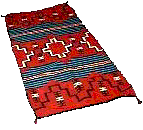

Navajo Rug Appraisal Co.®
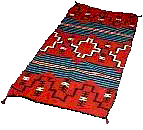
History of the Navajo Rug
Classic Period (prior to 1868)
During the Classic Period, the Navajo wove utilitarian items of clothing (blankets and other items) for their own use and for trade to the Spanish and Plains Indians. These items were woven using the wool from the Spanish Churro sheep introduced by Coronado in 1540 and again in 1598 by Don Juan Ornate. The Churro remained the primary wool source for Navajo weaving from at least as early as the Reconquest of New Mexico in 1692 which ended the Pueblo Rebellion of 1680 until the "Long Walk" of 1864. Included in items woven during this time period would have been the so-called "Chief's" blanket. Through the course of the 1800's the Chief's blanket evolved into 3 distinct styles or phases 1,2,3. The design of the First Phase Chief's Blanket consists of simple horizontal stripes of blue, brown and ivory. The Second Phase blankets, appearing around the mid 19th century, included rectangular motifs within the horizontal bands. Third Phase blankets have a diamond shaped motif in the center and terraced or serrated triangles at the sides and corners. It is an interesting irony that the Navajos have never had tribal chiefs.
Many could legitimately argue that the Classic Period ended much later than 1863-64. In truth, there were quite a number of "Classic" weavings (blankets) made after 1868, but the beginning of the end of the Classic Period was in 1864 with the "Long Walk" and the internment of 8000 Navajo people at Fort Sumner, New Mexico.

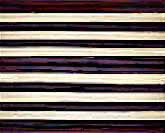
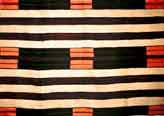
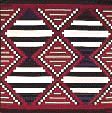
Transitional Period (1868 to 1900-10)
This period is when the Navajo were adapting from weaving wearing blankets to weaving rugs that were to be sold to Anglos. The market changed from trading directly to the Spanish and Plains Indians to trading at the trading post.
The Navajo people returned from Bosque Redondo in 1868. While interred, the Navajo had become accustomed to manufactured clothing and new materials for weaving. With most of the Churro sheep herds having been destroyed, they began to use commercially spun wool yarn and machine spun plied cotton string used for warp along with wool from the newly introduced sheep which were Merino cross breeds (14,000 sheep in 1869). The commercial materials, including synthetic dyes, were provided by the newly licensed local trading posts. In 1883 a more purebred Merino breed was introduced.
The Transitional rugs/blankets produced during this period were coarsely woven and most were very brightly colored. They are easily recognizable by the fuzzy thick wefts having been woven from the wool of the available sheep.
Also produced during this time were "Germantown" Navajo rugs woven from 3 ply or 4 ply machine spun wool yarn, usually on machine spun plied cotton warp. The name "Germantown" comes from the area near Philadelphia, Pa where most of the yarn was milled. These Germantown rugs were intricately styled and very colorful. Some were so wildly colored that they are called "Eyedazzlers."

Rug Period (1900 to 1930)
The traders played an important role in the development of the Navajo rug. Weavers gradually transformed from the weaving of blankets to textiles suitable for use on the floors of Anglo (for lack of a better term) homes. Because the weavings were now being sold as rugs, they had to look like rugs which meant that they had to look like Oriental rugs. The rugs had to have a border to be accepted and, in fact many Navajo rug designs were very close copies of Oriental rug designs.
Also because Anglos seem to equate weight with quality, there was the impetus to weave rugs of a heavier nature. These heavier weavings were more like what was familiar to Anglos as rugs and could withstand the foot traffic in an Anglo home. As can be verified by contemporaneous documents, traders sold most rugs by the pound. Many of these "Pound Rugs" exhibit the expected lack of technical quality but many do have a unique charm.
In the early part of this century traders like Juan Lorenzo Hubbell and J. B. Moore were instrumental in promoting Navajo weaving and developing distinctive styles. This period of time resulted in the further development of distinct styles and the eventual rebirth of traditional designs and higher technical quality. We now call these rugs, "Regional Rugs."


Revival Period (1930's to 1950)
The decline of sales of Navajo rugs has been blamed on a decline of quality and the introduction of French Rambouillet sheep. While this may have something to do with it, one should not overlook the effects of the Great Depression. The only market for Navajo rugs had dried up. This, coupled with the changing of ownership at many of the trading posts, resulted in a sharp decline of sales of Navajo rugs.
The Revival Period brought life back to the Navajo rug business. Mary Cabot Wheelwright along with Cozy McSparron of Chinle (beginning in 1920) and later, the Lipponcotts and Cousins of Wide Ruins (1939 to 1949) promoted the development of new vegetable dyes. The rugs were generally woven in stylized Classic or semi-classic designs without borders. Because the colors and designs fit into the fashion of many American interiors, and because the country was recovering economically, these rugs were a great success. The Crystal Revival, Chinle and Wide Ruins regional styles came about during this time

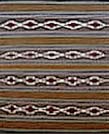

Modern Period (post WWII)
During this period of time we see the further development of "Regional" rugs such as the Ganado, Two Grey Hills, Teec Nos Pos etc., and an overall increase in the technical quality of the Navajo rug, at least in later years. With the changing of American society after WWII, the market for Navajo rugs changed as well. Dependable automobiles, Route 66 and new homes via the GI Bill all changed the demand for the type of Navajo handmade weavings. The need then was for high quality but moderately priced Indian arts and cheap curios bought by tourists on travels to the west. The rugs had be symmetric and very evenly woven with a bit more boldness in design. Quirks in the weave and coloration, and design mistakes were no longer thought of as part of the charm. The rugs had to be of a higher technical quality and therefore more exact and "perfect." Along with these new parameters, there was also a renewed demand for large size rugs, 6 x 9 and larger, to fit the newly acquired suburban homes. Rugs measuring were not uncommon during this period. There were many rugs woven during the late 50's, 60's and early 70's.
The later modern period brought about the growth of new regional styles in the last few decades. An example might be the Burntwater style using a quincunx design layout much like a Two Grey Hills but with numerous pastel colors. Another example would be the even more radical new style that is called Newlands. Bruce Burnham of Sanders, AZ, was the first to promote the weaving and sale of this style of rug which originated in the western part of the reservation at Blue Canyon and Coal Mine Mesa. He has also introduced new machine spun wool yarns and has worked to extend another new style that might be called a "Germantown Revival" style.
During the post WWII period, we can also clearly see the concept of Non-regional styles; rugs that cannot be pinpointed to a particular regional area. While the idea of regionalism was always somewhat shaky, the economic development of the Navajo and all American people after WWII contributed to the exchanging and evolution of design ideas. New roadways, dependable vehicles, telephone all played a role in this evolution. Now there are rugs woven in non-traditional designs for display on a wall, not for use on the floor. We can also see traditional styles woven in non-traditional places. Today a Storm pattern rug might be woven in Ganado, Shiprock, or even Tucson.



Have you had your rug appraised?
 Navajo Rug Appraisal Co.®
Navajo Rug Appraisal Co.®